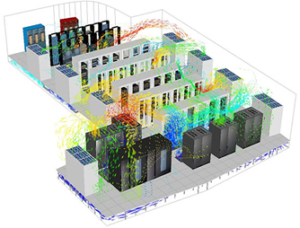1. Modern Will Be the New Software-Defined
 Isn’t everyone tired of hearing software-defined at the front of every new product or innovation? Not only has it been over-used to the point of meaninglessness, it is also tough to say to a customer or investor without inducing a reflexive eye-roll. Now don’t get mean wrong, software is still eating the world, but in the infrastructure world, software impact is reaching a point of diminishing returns. The SD pieces are in place – SDN, SDS, virtualization, containerization, and orchestration. Together these components create a modern infrastructure architecture on which applications and services can be developed and deployed. Gartner will soon release a new MQ titled ‘Data Infrastructure Modernization’ to replace the MQs for ‘cloud storage gateways’ and enterprise file synchronization and sharing. Now you may be thinking “Wow, what could be worse than ‘software-defined?’ Oh right, ‘data infrastructure modernization’ is worse.” You are correct, but the use of ‘modern’ to describe various pieces of infrastructure will kick into high gear. It already has and can be seen in the messaging of many companies.
Isn’t everyone tired of hearing software-defined at the front of every new product or innovation? Not only has it been over-used to the point of meaninglessness, it is also tough to say to a customer or investor without inducing a reflexive eye-roll. Now don’t get mean wrong, software is still eating the world, but in the infrastructure world, software impact is reaching a point of diminishing returns. The SD pieces are in place – SDN, SDS, virtualization, containerization, and orchestration. Together these components create a modern infrastructure architecture on which applications and services can be developed and deployed. Gartner will soon release a new MQ titled ‘Data Infrastructure Modernization’ to replace the MQs for ‘cloud storage gateways’ and enterprise file synchronization and sharing. Now you may be thinking “Wow, what could be worse than ‘software-defined?’ Oh right, ‘data infrastructure modernization’ is worse.” You are correct, but the use of ‘modern’ to describe various pieces of infrastructure will kick into high gear. It already has and can be seen in the messaging of many companies.
In fairness to the terminology spinners, it is more than just a nomenclature problem. The intent of the ‘modern’ term is to describe an infrastructure that takes into its entirety all of the shifts over the past 5 plus years: 1) compute virtualization; 2) cloud services; 3) software-defined infrastructure; 4) micro-service application development; and 5) mobile-first users. ‘Modern Infrastructure’ will take this Mod Squad as givens with vendors and service providers making design decisions that optimize for this new modern reality.
2. Special Purpose Orchestration Will Become a Thing
 Infrastructure Orchestration – from languages like Chef, Puppet and Ansible, to systems like vSphere(TM), OpenStack and Kubernetes – has been an area of significant innovation for years within IT. Orchestration, though, is still the domain of sophisticated IT organizations that have the scale and budget to hire large devops organizations to write and maintain the needed code that is specific to that organization’s applications and services. The only way to bring the benefits of orchestration to the rest of the market is to ‘productize’ special purpose orchestration suites for particular industries or market segments. The best of these new ‘special purpose orchestration’(SPO) solutions will leverage all the latest in the Mod Squad capabilities to deliver on the promise of orchestration for the specific industries for which they are designed. An interesting and potentially complicating by-product of these SPO solutions is that they will have dependencies across the entire infrastructure on which they are implemented. This will potentially make the “System Requirements” list for a traditional software product seem simple and quaint by comparison.
Infrastructure Orchestration – from languages like Chef, Puppet and Ansible, to systems like vSphere(TM), OpenStack and Kubernetes – has been an area of significant innovation for years within IT. Orchestration, though, is still the domain of sophisticated IT organizations that have the scale and budget to hire large devops organizations to write and maintain the needed code that is specific to that organization’s applications and services. The only way to bring the benefits of orchestration to the rest of the market is to ‘productize’ special purpose orchestration suites for particular industries or market segments. The best of these new ‘special purpose orchestration’(SPO) solutions will leverage all the latest in the Mod Squad capabilities to deliver on the promise of orchestration for the specific industries for which they are designed. An interesting and potentially complicating by-product of these SPO solutions is that they will have dependencies across the entire infrastructure on which they are implemented. This will potentially make the “System Requirements” list for a traditional software product seem simple and quaint by comparison.
3. Storage Geo-tiering Will Approach Importance
 Automated Storage Tiering – moving data between lower performing and higher performing storage types has been part of storage systems in data centers for years. This has typically been executed successfully only within the data center and usually within a single vendor system. The beginning of automated storage geo-tiering began with cloud storage gateways as an almost necessity for connecting traditional applications effectively to cloud storage. A lot of venture capital flowed into the cloud storage gateway market and produced very little return as an industry segment which caused the concept of geo-tiering to fall out of favor.
Automated Storage Tiering – moving data between lower performing and higher performing storage types has been part of storage systems in data centers for years. This has typically been executed successfully only within the data center and usually within a single vendor system. The beginning of automated storage geo-tiering began with cloud storage gateways as an almost necessity for connecting traditional applications effectively to cloud storage. A lot of venture capital flowed into the cloud storage gateway market and produced very little return as an industry segment which caused the concept of geo-tiering to fall out of favor.
Venture capital whims aside, the need for geo-tiering of data has only become more important as applications and data have become more ‘cloudy’ and users have become more mobile. With the continuing crush of data growth, making certain that the right data is where it is needed, when it is needed, will only become more important. The best geo-tiering solutions will be able to move only the needed data right before or right when it is needed, and will know when the data is no longer needed.
4. Hardware Will Become Strategic Again
 After years of focus on software-defined and cloud everything, investors and buyers will begin to understand the benefit of hardware again. All software must run on something – something with a CPU, memory, drives, controllers, network cards, and blinky lights. The cloud, as they say, is just someone else’s computers. The priority of hardware focus has taken a backseat to the agility needs of business. Making IT services easy to provision and reconfigure is crucial, but it is beginning to be ubiquitous. Now differentiation of cloud and IT services needs to find new dimensions. Developing and using hardware that is purpose built for the software-defined data center so that space, energy and performance efficiency gains can be made will become a big part of that. Look for new entrants and current players in the hardware market to introduce servers and components that assume cloud-first in their design and thereby create new competitive differentiation for cloud operators.
After years of focus on software-defined and cloud everything, investors and buyers will begin to understand the benefit of hardware again. All software must run on something – something with a CPU, memory, drives, controllers, network cards, and blinky lights. The cloud, as they say, is just someone else’s computers. The priority of hardware focus has taken a backseat to the agility needs of business. Making IT services easy to provision and reconfigure is crucial, but it is beginning to be ubiquitous. Now differentiation of cloud and IT services needs to find new dimensions. Developing and using hardware that is purpose built for the software-defined data center so that space, energy and performance efficiency gains can be made will become a big part of that. Look for new entrants and current players in the hardware market to introduce servers and components that assume cloud-first in their design and thereby create new competitive differentiation for cloud operators.
5. Open Source Will Become a Storage Benefit
 While open source projects for storage are making terrific headway in the market, especially Ceph, Gluster and Swift, they have been treated as an interesting anomaly instead of a strategic benefit. All buyers seem to be intrigued by the use of open source in storage systems, but some give it about as much importance as the color of the LEDs or the animations in the UI. The big open source storage projects have powerful core capabilities, but they are not full-featured storage systems limiting their appeal. As more storage products come on to the market with open source storage embedded in them, the benefits of open source will begin to get weighed heavily in buyer decisions.
While open source projects for storage are making terrific headway in the market, especially Ceph, Gluster and Swift, they have been treated as an interesting anomaly instead of a strategic benefit. All buyers seem to be intrigued by the use of open source in storage systems, but some give it about as much importance as the color of the LEDs or the animations in the UI. The big open source storage projects have powerful core capabilities, but they are not full-featured storage systems limiting their appeal. As more storage products come on to the market with open source storage embedded in them, the benefits of open source will begin to get weighed heavily in buyer decisions.
Like other markets, open source provides storage products with rapid feature development cycles, rapidly increasing stability, fast security enhancements, and openness and consistency of operation across platforms. Expect the weighting of the ‘open source’ column in the RFP response table to be given enough mass to tip the scales in favor of more than a few storage systems that embed open source in them.
Back to all resources
Get Started with Vecima
We help our customers evolve their networks with cloud-based solutions that deliver ground-breaking speed, superior video quality, and exciting new services to their subscribers.
Contact Us

